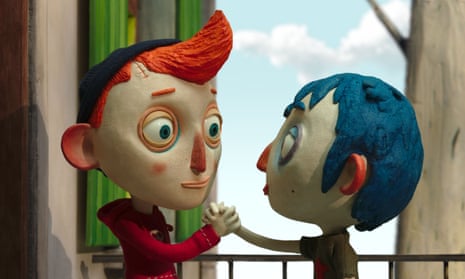Last week, I swooned over Michaël Dudok de Wit’s The Red Turtle, a French-Belgian-Japanese co-production which was nominated for the best animated feature Oscar. Also recommended in that same category was My Life As a Courgette (or My Life As a Zucchini in the US), a wonderfully affecting French-Swiss stop-motion masterpiece based on Gilles Paris’s book Autobiographie d’une courgette. Directed by feature first-timer Claude Barras from a screenplay by Girlhood writer-director Céline Sciamma, this tale of resilient children surviving abuse and abandonment may sound tough and unpalatable. Yet despite the spectre of parental alcoholism, drug addiction and worse, this beautifully tender and empathetic film addresses kids and adults alike in clear and compassionate tones that span – and perhaps heal – generations.
We first meet nine-year-old Icare, nicknamed Courgette, alone in his room, surrounded by crayons and empty beer cans, the detritus of a dysfunctional home life. Downstairs, his mother belches and curses at the television (“Liars! Filthy liars!”). A torn family photo establishes the absence of a father, a blank space on to which Courgette has projected fantastical dreams of a superdad. But after an altercation on the staircase (“I think I killed my mum”), he finds himself sent to a children’s home where, in the words of one resident: “We’re all the same. There’s nobody left to love us…”
Only the most hard-hearted viewer, however, could fail to love these youngsters, with their larger-than-life heads, long, lanky arms and minimally constructed faces upon which symphonies of understated emotions are registered. Each character is realised with deceptively simple strokes: Simon, the supposed bully with a telltale scar whose parents “took drugs all the time”; Jujube/Georgie, whose mother “went completely nuts” and made him eat toothpaste; Ahmed, the “girlie who wets his bed” as a result of post-traumatic stress; and Alice, who hides her haunted eyes behind a shock of yellow hair and has nightmares about the “real creep” dad who’s now in jail.
Into this group comes Camille, a Kafka-reading enigma whose name and appearance echo that of Courgette, and whom he recognises as a kindred spirit. “It shines in her eyes,” he whispers, “that she saw it all”, a phrase that succinctly encapsulates the film’s deft use of enlarged windows to the soul.
Combining the poetic possibilities of animation with the down-to-earth dialogue of tough real lives (think Henry Selick meets Ken Loach), Barras succeeds brilliantly in his stated ambition to “make a film about children that speaks to them about abuse and its remedies in today’s world”. Part of the magic lies in the gentle rhythm of the editing, eschewing quick cuts for unfashionably lengthy takes, lingering upon tiny reactions – a blink here, a shrug there – through which the real story unfolds. The landscapes in which these children live may be full of shadows, but the use of bold colours – red, blue, brown, yellow – adds a bright spark of defiance to their characters.
Sciamma’s screenplay combines revealingly frank and poignant observations about disrupted lives with laugh-out-loud discussions of sex (“my parents had films… the man’s willy explodes”) and moments of tenderness made all the more powerful by their understatement. A scene in which the kids dance beneath a glitterball to Eisbär by Swiss band Grauzone is as vibrant and invigorating as the Diamonds sequence from Girlhood, a moment of pure character-building musical delight. Subtly subversive, too, that the narrative should celebrate social workers and lend sympathetic voice to a policeman, all of whom are portrayed in an unfashionably nurturing light.
Sciamma cites the Dardenne brothers as influential, while Barras acknowledges sources ranging from Bambi to The 400 Blows. I thought I spotted a sly nod to Miyazaki in the graffiti on the wall of the children’s home, and even a hallucinogenic flash of Dougal and the Blue Cat in a ghost train ride during a fairground outing. Whatever the sources, the end result is wholly remarkable, whether in subtitled French or the English-dubbed version. I watched both, and while the former seemed marginally more melancholic, the latter still moved me to tears, buoyed up by Sophie Hunger’s plaintive music that perfectly accompanies the lyrical humanism of this lovely movie.

Comments (…)
Sign in or create your Guardian account to join the discussion